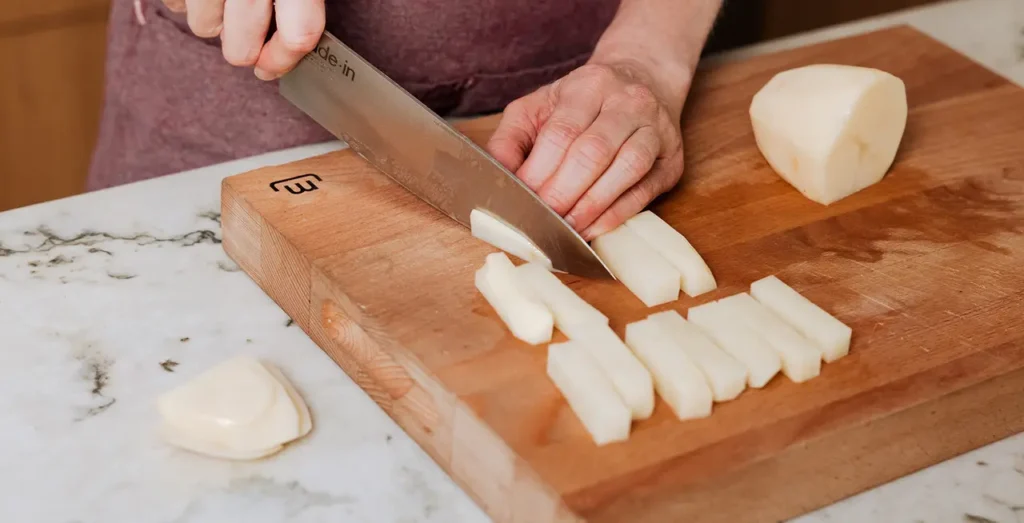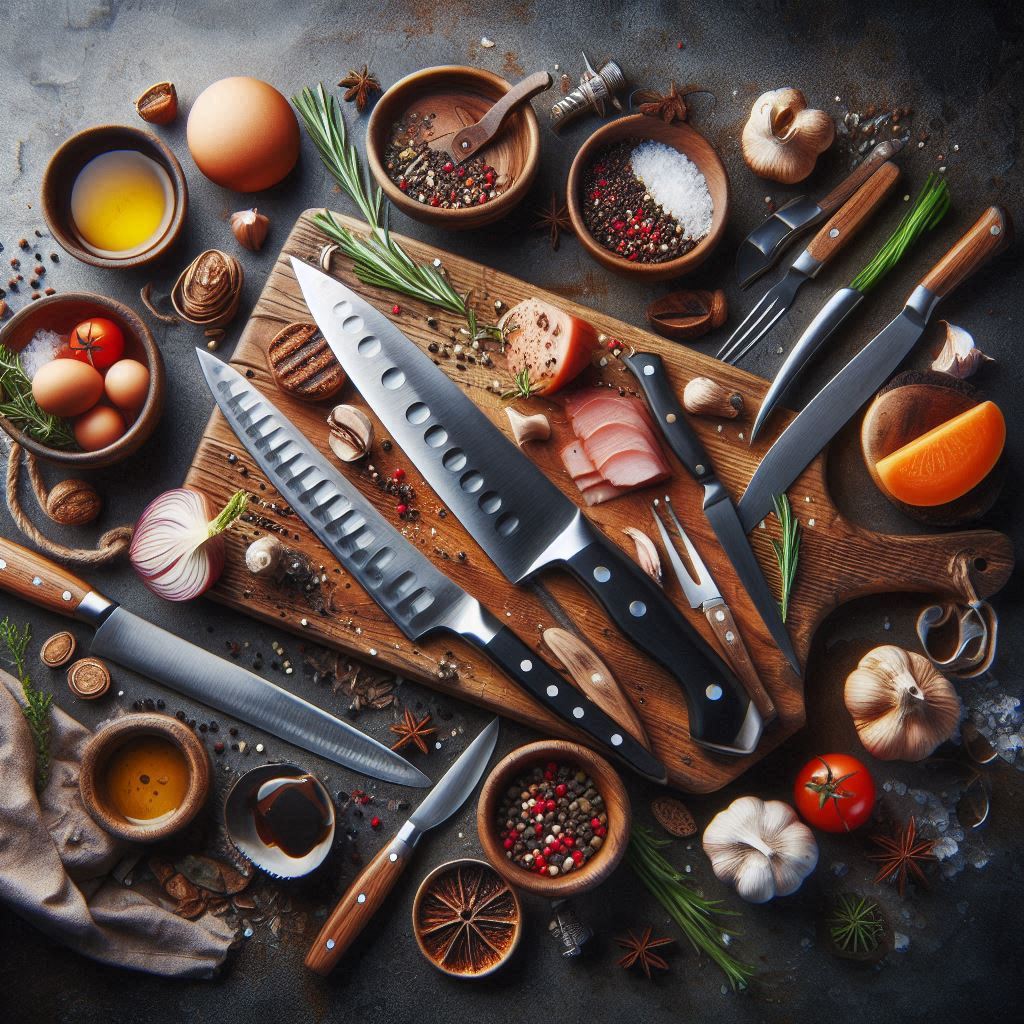Introduction
Welcome to the world of culinary mastery! Whether you’re an aspiring home cook or a seasoned chef, mastering knife skills is an essential part of creating exquisite dishes. Knives are the most fundamental tools in the kitchen, and knowing how to use them efficiently can significantly elevate your cooking game. In this comprehensive guide, we will delve into the top 10 knife skills every chef must master for precision, safety, and creativity in the kitchen. From basic cuts to advanced techniques, this post will equip you with the knowledge and confidence to handle your kitchen knives like a pro.
1. The Basic Grip: Foundation of All Knife Skills
Subheading: Master the Art of Holding Your Knife
The first step to mastering knife skills is learning the proper grip. A good grip provides control, reduces fatigue, and enhances precision. Here’s how to hold your knife correctly:
- Pinch Grip: Pinch the blade between your thumb and index finger just in front of the bolster (the thick part of the blade). Wrap your remaining fingers around the handle.
- Handle Grip: Wrap all fingers around the handle, but this grip is less recommended as it offers less control.
2. The Rock Chop: Swift and Safe Cutting
Subheading: Efficiently Slice and Dice with the Rock Chop
The rock chop is a fundamental cutting technique that involves a rocking motion to slice through ingredients. Here’s how to do it:
- Setup: Place the tip of your knife on the cutting board.
- Motion: Rock the knife back and forth while keeping the tip in contact with the board.
- Consistency: Use a consistent up-and-down motion to achieve even cuts.
3. The Slice: Smooth and Precise Cuts
Subheading: Achieve Perfectly Even Slices
Slicing is a fundamental knife skill that requires smooth, even strokes to produce uniform cuts. Here’s how to master it:
- Stance: Stand with your feet shoulder-width apart, and hold the knife with the proper grip.
- Motion: Use a forward and backward motion, allowing the weight of the knife to do the work.
- Speed: Focus on consistency rather than speed to achieve even slices.
Tip: Control Your Speed
Slower, deliberate cuts ensure precision, especially when slicing delicate ingredients like tomatoes or onions.
4. The Dice: Uniform Cubes for Even Cooking
Subheading: Master Dicing for Perfectly Sized Ingredients
Dicing involves cutting ingredients into small, uniform cubes. This technique is crucial for even cooking and presentation. Here’s how to dice like a pro:
- Prep: Start by slicing the ingredient into even strips.
- Crosscut: Turn the strips and cut across them to create uniform cubes.
- Size: Aim for consistent sizes to ensure even cooking.
Pro Tip: Use a Guide Hand
Keep your non-dominant hand in a claw shape to guide the knife and protect your fingers.
5. The Julienne: Elegant Thin Strips
Subheading: Create Fine Strips for Garnishes and Stir-Fries
Julienne is a technique for cutting ingredients into thin, matchstick-like strips. It’s perfect for garnishes, salads, and stir-fries. Here’s the process:
- Prep: Cut the ingredient into manageable lengths.
- Slice: Slice into thin, even strips.
- Consistency: Keep the strips uniform for an elegant presentation.
6. The Brunoise: Tiny and Precise Dice
Subheading: Achieve Fine Dice for Sophisticated Dishes
The brunoise cut involves dicing ingredients into tiny, uniform cubes, typically 1/8 inch. It’s often used for garnishes and fine dishes. Here’s how to do it:
- Julienne First: Start with a julienne cut.
- Crosscut: Turn the julienne strips and dice into small cubes.
- Precision: Aim for consistent, tiny cubes.
Pro Tip: Use a Sharp Knife
A sharp knife ensures clean cuts and prevents bruising delicate ingredients like herbs and vegetables.
7. The Chiffonade: Elegant Herb Strips
Subheading: Slice Herbs and Greens with Finesse
Chiffonade is a technique for cutting herbs and leafy greens into thin ribbons. It’s perfect for garnishes and salads. Here’s how to chiffonade:
- Stack Leaves: Stack the leaves neatly.
- Roll: Roll the leaves tightly into a cigar shape.
- Slice: Slice across the roll to create thin ribbons.
8. The Paysanne: Rustic and Versatile Cuts
Subheading: Cut Vegetables into Rustic, Flat Shapes
The paysanne cut involves slicing vegetables into thin, flat shapes. It’s a versatile cut used in rustic dishes and soups. Here’s how to do it:
- Prep: Slice the vegetable into thin planks.
- Shape: Cut the planks into desired shapes, typically squares or triangles.
- Uniformity: Keep cuts consistent for even cooking.
Pro Tip: Use for Root Vegetables
The paysanne cut is ideal for root vegetables like carrots, potatoes, and turnips, adding a rustic touch to soups and stews.
9. The Batonnet: Perfect Sticks for Frying and Roasting

Batonnet Cut Potatoes for Frying
Subheading: Create Uniform Sticks for Cooking
The batonnet cut involves slicing ingredients into uniform sticks, typically 1/4 inch thick. It’s perfect for frying, roasting, and crudités. Here’s how to do it:
- Prep: Cut the ingredient into manageable lengths.
- Slice: Slice into even sticks, aiming for consistent thickness.
- Use: Ideal for French fries, roasted vegetables, and dipping.
10. The Tourne: Classic French Technique
Subheading: Create Elegant, Seven-Sided Vegetables
The tourne cut is a classic French technique that involves shaping vegetables into elegant, seven-sided football-like shapes. Here’s how to do it:
- Prep: Cut the vegetable into manageable lengths.
- Shape: Use a paring knife to carve seven equal sides, rotating the vegetable as you cut.
- Practice: This technique requires practice for precision and uniformity.
Pro Tip: Use for Presentation
The tourne cut is often used for high-end presentations, adding a touch of sophistication to your dishes.
Conclusion
Mastering knife skills is an essential part of becoming a proficient cook. By learning and practicing these top 10 knife techniques, you’ll enhance your efficiency, precision, and safety in the kitchen. From the basic grip to advanced cuts, each skill adds to your culinary repertoire, allowing you to create masterful dishes with confidence. So grab your knife, practice these techniques, and transform your cooking experience!
FAQs
1. What is the most important knife skill to master first?
The most important knife skill to master first is the basic grip. A proper grip ensures control, safety, and precision, forming the foundation for all other knife skills.
2. How often should I sharpen my kitchen knives?
It’s recommended to sharpen your kitchen knives every 6-12 months, depending on usage. Regular honing with a steel rod can maintain the edge between sharpenings.
3. What type of knife is best for beginners?
A chef’s knife is the best all-purpose knife for beginners. It is versatile and suitable for most cutting tasks, making it an essential tool in any kitchen.
4. How can I improve my knife skills?
Practice regularly and focus on proper technique. Watching instructional videos, taking cooking classes, and following detailed guides like this one can also help improve your knife skills.
5. Are there any safety tips for using kitchen knives?
Always use a sharp knife, as dull knives require more force and are more prone to slipping. Keep your fingers tucked in using the claw grip, and always cut away from your body.


